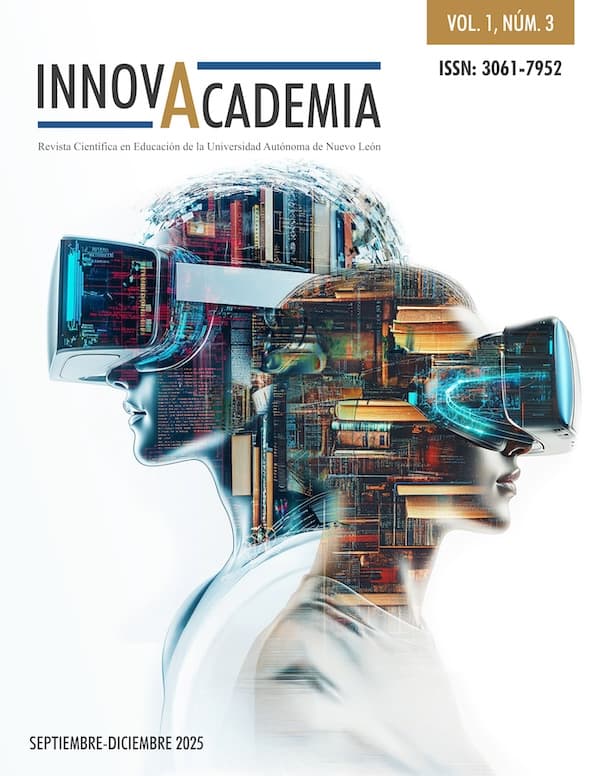Media and information literacy among future communicators in Nuevo León: an expert perspective
DOI:
https://doi.org/10.29105/innoacad.v1i3.53Keywords:
media education, mass communication, critical thinkingAbstract
The objective of the study was to explore the perceptions of six communication and education professionals regarding the Media and Information Literacy (MIL) skills of communication science students in Nuevo León. A purposive, non-probability sampling design was used. The instruments used were in-depth interviews analyzed through an inductive process of organizing data into categories. The investigation suggests that students have difficulty finding, evaluating, and using information from diverse sources, as well as analyzing its veracity, identifying its purposes, and recognizing manipulation techniques. The analysis indicates that the low level of basic communicative skills may be related to deficiencies in teaching within higher education institutions specializing in communication sciences in the northeastern Mexican state of Nuevo León.
Downloads
References
Alcolea-Díaz, G., Reig, R. y Mancinas-Chávez, R. (2020). Currículo de Alfabetización Mediática e Informacional de la UNESCO para profesores desde la perspectiva de la estructura de la información. Comunicar, 28(62), 97–106. https://doi.org/10.3916/c62-2020-09 DOI: https://doi.org/10.3916/C62-2020-09
Amat, A., Piquer, M., Fabrés, G. y Farné, A. (2022). Capítulo 1 La alfabetización mediática e informacional en la educación formal: un reto necesario. Espejo De Monografías De Comunicación Social, (9), 13-33. https://doi.org/10.52495/c1.emcs.9.p95 DOI: https://doi.org/10.52495/c1.emcs.9.p95
Bulger, M., & Davison, P. (2018). The promises, challenges, and futures of media literacy. Journal of Media Literacy Education, 10(1), 1-21. https://doi.org/10.23860/jmle-2018-10-1-1 DOI: https://doi.org/10.23860/JMLE-2018-10-1-1
Chaves, A. (2001). Implicaciones educativas de la teoría sociocultural de Vigotsky. Educación, 25(2), 59–65. https://www.redalyc.org/pdf/440/44025206.pdf DOI: https://doi.org/10.15517/revedu.v25i2.3581
Creswell, J., & Poth, C. (2016). Qualitative inquiry and research design: Choosing among five approaches. Sage publications. https://books.google.com.mx/books?id=DLbBDQAAQBAJ
Denzin, N. y Lincoln, Y. (2012). Introducción general: El campo de la investigación cualitativa. En N. K. Denzin y Y. S. Lincoln (Eds.), Manual de investigación cualitativa: Volumen I. Fundamentos y tradiciones cualitativas (pp. 27–51). Barcelona, España: Gedisa. https://calidadsinlagrimas.com/wp-content/uploads/2025/06/denzin__cap_i__introduccion_general_el_campo_de_la_investigacion_cualitativa_.pdf
De Leyn, T., Waeterloos, C., De Wolf, R., Vanhaelewyn, B., Ponnet, K., & De Marez, L. (2021). Teenagers’ reflections on media literacy initiatives at school and everyday media literacy discourses. Journal of Children and Media, 16(2), 221–239. https://doi.org/10.1080/17482798.2021.1952463 DOI: https://doi.org/10.1080/17482798.2021.1952463
Fedorov, A., & Mikhaleva, G. (2020). Current trends in media and information literacy in research and scientific publications of the early 21st century. International Journal of Media and Information Literacy, 5(2), 153–163. https://doi.org/10.13187/ijmil.2020.2.153 DOI: https://doi.org/10.13187/ijmil.2020.2.153
Fuller, M., Heijne-Penninga, M., Kamans, E., van Vuuren, M., de Jong, M., & Wolfensberger, M. (2018). Identifying competence characteristics for excellent communication professionals: A work field perspective. Journal of communication management, 22(2), 233-252. https://doi.org/10.1108/jcom-07-2016-0051 DOI: https://doi.org/10.1108/JCOM-07-2016-0051
Grizzle, A., Wilson, C., Tuazon, R., Cheung, C., Lau, J., Fischer, R., Gordon, D., Akyempong, K., Singh, J., Carr, P., Stewart, K., Tayie, S., Suraj, O., Jaakkola, M., Thésée, G., & Gulston, C. (2021). Media and information literate citizens: think critically, click wisely! https://zuscholars.zu.ac.ae/cgi/viewcontent.cgi?article=5561&context=works
McMillan, J. y Schumacher, S. (2005). Investigación educativa: Una introducción conceptual (J. Sánchez Baides, Trad.; 5ª ed.). Madrid, España: Pearson Educación. https://des-for.infd.edu.ar/sitio/upload/McMillan_J._H.__Schumacher_S._2005._Investigacion_educativa_5_ed..pdf
Potter, W. (2022). Analysis of definitions of media literacy. Journal of Media Literacy Education, 14(2), 27-43. https://doi.org/10.23860/jmle-2022-14-2-3 DOI: https://doi.org/10.23860/JMLE-2022-14-2-3
Sales, D. (2020). Definición de alfabetización informacional de CILIP, 2018. Anales de Documentación, 23(1). https://doi.org/10.6018/analesdoc.373811 DOI: https://doi.org/10.6018/analesdoc.373811
Schulenkorf, T., Krah, V., Dadaczynski, K., & Okan, O. (2021). Addressing health literacy in schools in Germany: Concept analysis of the mandatory digital and media literacy school curriculum. Frontiers in Public Health, 9, Artículo 687389. https://doi.org/10.3389/fpubh.2021.687389 DOI: https://doi.org/10.3389/fpubh.2021.687389
Scull, T., Dodson, C., Geller, J., Reeder, L., & Stump, K. (2022). A media literacy education approach to high school sexual health education: Immediate effects of media aware on adolescents’ media, sexual health, and communication outcomes. Journal of Youth and Adolescence, 51, 708–723. https://doi.org/10.1007/s10964-021-01567-0 DOI: https://doi.org/10.1007/s10964-021-01567-0
Toruño, C. (2020). El currículum en el contexto costarricense: propuesta de definiciones para su conceptualización. Revista Ensayos Pedagógicos, 15(1), 39-59. https://doi.org/10.15359/rep.15-1.2 DOI: https://doi.org/10.15359/rep.15-1.2
Trejo-Quintana, J., Morales-Martinez, G. E., & Hernandez-Alvarez, B. (2025). Cognitive diagnosis of media and digital literacy knowledge schema in Mexican high school students. Journal of Media Literacy Education, 17(1), 58-74. https://doi.org/10.23860/JMLE-2025-17-1-4 DOI: https://doi.org/10.23860/JMLE-2025-17-1-4
Tselykh, M. (2020). “Media Education is the Key to Understanding the Modern Information Society”: Interview with Prof. Dr. Alexander Fedorov. International Journal of Media and Information Literacy, 5(1), 103-107. https://doi.org/10.13187/ijmil.2020.1.103 DOI: https://doi.org/10.13187/ijmil.2020.1.103
United Nations Educational, Scientific and Cultural Organization. (2023). Navigating the infodemic with MIL: Media and information literacy (F. Chibás Ortiz y S. Novomisky, Eds.). París, Francia: UNESCO. https://unesdoc.unesco.org/ark:/48223/pf0000385748
Wilson, C., Grizzle, A., Tuazon, R., Akyempong, K. y Cheung, C.-K. (2011). Alfabetización mediática e informacional: Curriculum para profesores. UNESCO. https://unesdoc.unesco.org/ark:/48223/pf0000216099/PDF/216099spa.pdf.multi
Yeleussiz, A., & Qanay, G. (2025). Media Literacy in Kazakhstan: Educators’ Perspectives and Policy Implementation. Journal of Curriculum Studies Research, 7(1), 1- 25. https://doi.org/10.46303/jcsr.2025.1 DOI: https://doi.org/10.46303/jcsr.2025.1
Downloads
Published
How to Cite
Issue
Section
License
Copyright (c) 2025 Carlos Emiliano Ortega Gutiérrez, Héctor Alvarado Lumbreras

This work is licensed under a Creative Commons Attribution-NonCommercial-ShareAlike 4.0 International License.
Los autores y autoras conservan los derechos de autor y otorgan a InnovAcademia el derecho de la primera publicación de sus trabajos, los cuales se publican bajo la licencia Creative Commons Atribución-NoComercial-CompartirIgual 4.0 Internacional (CC BY-NC-SA 4.0), por lo cual el usuario es libre de usar, compartir y adaptar el contenido de la revista siempre que se otorgue el crédito, no se use para fines comerciales, y se comparta cualquier material derivado bajo la misma licencia CC.
Política de Autoarchivo
Los autores y autoras pueden establecer acuerdos adicionales de licencia no exclusiva para la distribución de la versión publicada de su artículo o ensayo (por ejemplo, depositarlo en un repositorio institucional o incluirlo en un libro), siempre y cuando se mencione que la publicación original se realizó en esta revista.
Se permite y se alienta a los autores a publicar su trabajo en línea (por ejemplo, en repositorios institucionales o en su sitio web) antes y durante el proceso de envío, ya que puede conducir a intercambios productivos, así como a una citación más temprana y mayor del trabajo publicado (consulte El efecto del acceso abierto).






